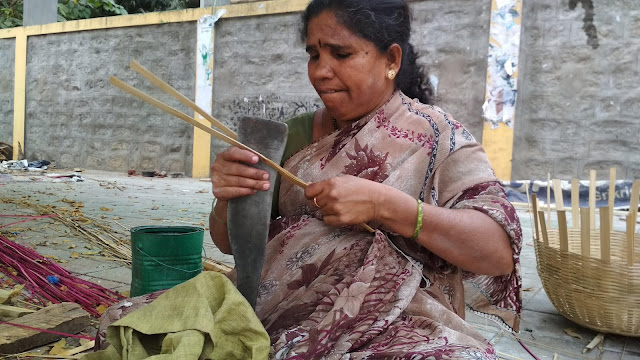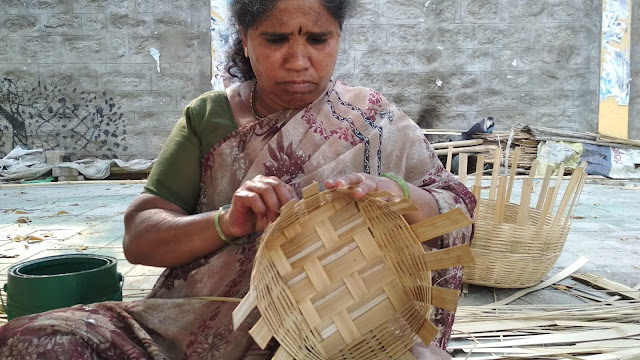Making with Artisan: K.R. Market Bamboo Basket Weavers
It is the 9th of February. It is supposed to be winter but Bangalore’s weather has started to change like it usually does around this time of the year. So it is sunny, yet pleasant, with a breeze. The road the weavers had chosen to settle down on was a wide one. It was busy with vehicular traffic but not overwhelmingly so. There are enough trees for enough shady spots and the weavers having used their skill to it’s best have built themselves cozy shacks within which you can find the items they wish to sell. The weavers are seated either inside or around their shacks. I walk along the road for a while without saying anything. People are looking at me; I must seem keen. I on the other hand am busy observing the variety in their patterns. There are square, round, curved ones and then there are big, small and minuscule ones. I want to own them, but no, I’ll learn to make them instead I tell myself.
No one has spoken to me yet. No one from the first 5 or 6 shacks I crossed. I walk into the 7th one and an old man starts chatting with me in Kannada. I try my hand with Kannada but in a few minutes I break and ask him if anyone here speaks Tamil or Hindi. To my utmost delight, he points at a smiling woman who walks towards me and barking enthusiastic questions at me. I have found my teacher!
Learning to weave (Basket Number: 1)
My teacher, Sujata Akka , and I find a shaded spot a little away from the rest of her crew. We settle down and we begin. I’m not sure why I choose to share with my teacher that I have in the past weaved baskets out of palm leaves. Maybe it is my way of telling her not to be too careful with me. She gets started by placing 6 wide strips of bamboo that she has already cut one on top of another to form something of a star. She then picks up two thin and long strips of bamboo and begins the weaving process. One up, one down, one up, one down.
She’s done about one or two rounds now and my hands are itching to get started. Maybe this is exactly why I mentioned to her that I have weaved before, I’m a little afraid that she’ll do all the tough bits for me. So I ask, ‘Akka, can I see it a little carefully please? I’m not sure I understand what you are doing.” I don’t want to be too pushy. But she senses my impatience I think. “Let me make it a little firm”, she says. “Then I’ll hand it over to you and you can have a go at it, all by yourself.” She asks me if I’ve eaten. I tell her I’ve eaten a dahi vada. This information doesn’t interest her or bother her - she has no response to it. Maybe she asked, simply to ask. Or maybe she’s hungry and thinking about food.
Before she hands the base to me she gives me her one and only real instruction ‘onu bittu onu’ (Leave one and weave one), somewhere between Kannada and Tamil. I start doing it but old fears appear - What if I make it too lose? “Is this not tight enough? Do I have to make it tighter?” I ask her. But like most folks who work with their hands, she isn’t bothered about these little things. I wonder if mistakes like this are a part and parcel of working with ones hands. They are almost unavoidable and in that their inevitability in the learning process becomes apparent. She doesn’t even bother responding to my question really. ‘It’s correct right now”, she says as she takes it from my hand and shows me how to attach a new stick when the first one ends.
Our relationship is still a little tight I’m sensing. She doesn’t miss a chance to tell me that I’m doing it ‘correctly’ and she speaks to me using the epithets for respect ‘pinnungo, vidungo, vechukungo’. There is a class divide between us and it hasn’t broken just yet. She assumes that I am in a position of power in this interaction. In reality it is she, who is the teacher (with something to offer) and me, who is the learner (with so much to gain) but money changes this equation dramatically. However, this relationship is changing almost constantly as she watches me fumble and make mistakes. The neengal has changed to nee, the pinnungo has change to pinnu, vidungo to vidu. “Put it on your lap, please. It will not hurt you. You can do it like I do.” I place it on my lap and start to build upwards pushing the longer vertical strips inwards as I continue to weave horizontally.
It is already so firm and strong. I can’t help but compare it to the material and weave of the palm basket. Both, the material and the weave are completely different from each other. There is something familiar about the process, yet it feels completely different too. While my hands get used to the weave quite easily, the same can’t be said about the material. I am too scared to bend it, I don’t know if I will break it, I cannot tell what it means if there is a gentle crack on the stick. Should I remove it, break it away, replace it? Or is it fine and capable of going further down this journey with me?
There is an old lady, Sujata Akka’s mother-in-law, sitting a few feet away from us. She occasionally chats with my teacher about this and that - about women in the community, about the lives of others, about the weather and money. My teacher tells her about me too; that I have in the past woven palm leaf baskets. She attributes my abilities at the task I am performing before her now to this past experience. She is, I sense, a little impressed with how far I have come in our time together. I can’t tell if she means this or she is just being nice. On the other hand however, I find myself completely pleased with the task at hand - the tiredness I was feeling in my body earlier has disappeared completely. Over and over again she tells me how to hold it. Over and over again, she tells me not to be worried - to just go on and do it tightly. “Aa apdi” (Yes! Like that!) she tells me as she watches my weave each time.
It is true, I have to admit, that this weave has been a lot easier to do so far in comparison to the other one I know. Yet, I am unable to grade them into better or worse just yet. They each seem to offer a unique experience of their own. She takes the basket from my hand now and tightens it. I watch and repeat. There is no fear of failure creeping in. In some ways, my mind is so prepared for failure that I would welcome it with almost open arms at this point, even if I had to start all over again. Yet, nothing of the sort happens. My mistakes, if any, have been small and easily corrected either by me or by a knowing move from my teacher.
Once I have arrived at the optimal height for the basket we agree to finish it up. The final bits, are the toughest bits. With a knife like tool we cut off all the longer parts of the vertical bamboo. The task now is to open the loops of the thinner strips sufficiently from the inside so as to stuff the thicker strip through it. This step will lock the basket in place. However, this one tiny step is tougher than one would imagine. My lack of knowledge and understanding of the material makes me nervous that I will break it or destroy it and this makes me too careful in how I work with it. But after multiple trials and repeated demonstrations I finally manage to do it, even if it isn’t with great confidence. And finally my basket is done. I have to say I am beyond impressed with how this basket looks and how little time it took us to complete it. It’s a beauty!
Action for it’s own sake
(My experience of it)
- Awareness that the goal was to learn
- Immediate and unambiguous feedback from the material itself
- Concentration on the task at hand
- No symbolic meaning
- No resistance
- Learning through mimesis (?) (Teacher’s action showed me a possible path but I had to experiment to find out on my own)
- Action is bound by the context of the material’s specific materiality



Comments
Post a Comment